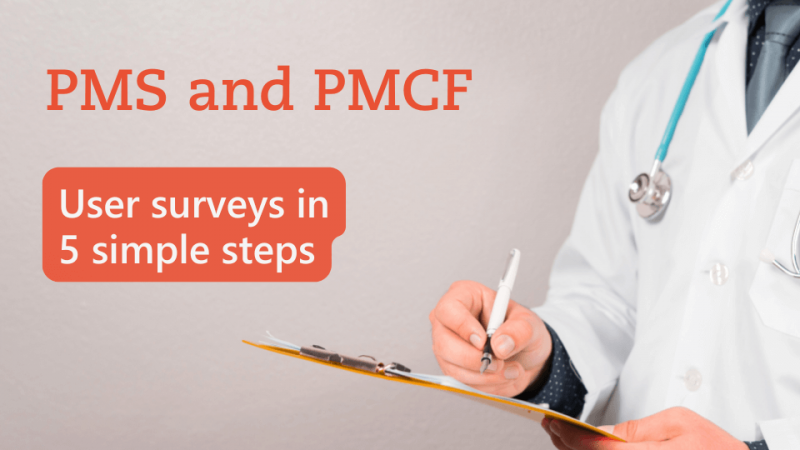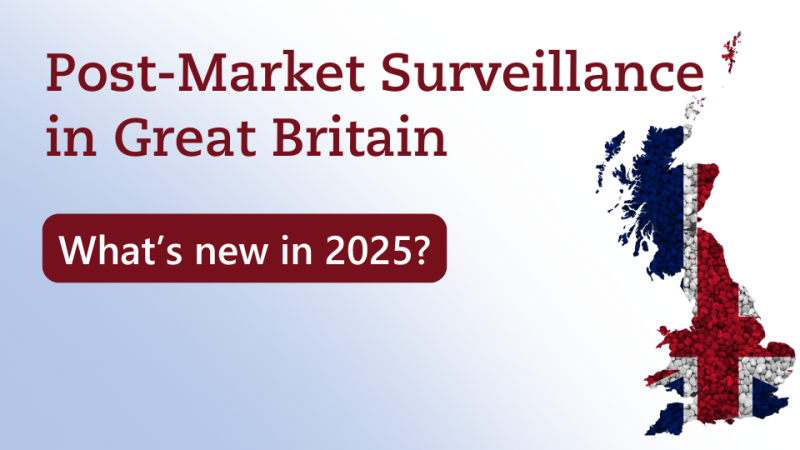PMS and PMCF with User Surveys: 5 steps to clinically relevant post-market data
18/08/2025
Do you have any questions about the article or would you like to find out more about our services? We look forward to hearing from you!Make a non-binding enquiry now
User surveys are a quick way to generate robust market and use data for many medical devices, closing gaps between the technical documentation and real-world use. Under the Medical Device Regulation (MDR), they are part of post-market surveillance (PMS) and, depending on the design, can also be used for post-market clinical follow-up (PMCF). This article explains when surveys are suitable, what level of evidence (including under MDCG 2020-6) is appropriate, and how to set up the questionnaire, target population, pretest, and analysis so that notified bodies can follow the results. It also clarifies how the data feed into the clinical evaluation and, as applicable, the performance evaluation.
Sometimes the objectives make it clear that the question should be considered under PMS rather than PMCF—for example, if the manufacturer wants to identify opportunities for improvement through user feedback.It should also be assessed whether the planned data are truly suitable for a user survey. Depending on the type of survey, it may be important that answers can be given as situationally or spontaneously as possible, or that they are collected using a structured, methodologically sound approach. The size and accessibility of the target group also play a decisive role in ensuring that representative, reliable data are collected. A clear participant-recruitment strategy is advisable, as is estimating willingness to participate to set a realistic sample size.
 Marie-Laure Castelain
Marie-Laure Castelain
 Claudia Möller
Claudia Möller
1. PMS and PMCF under the MDR: When is a user survey appropriate?
The Medical Device Regulation (EU) 2017/745 (MDR) noticeably raises the bar for PMS/PMCF. Many manufacturers ask: Is a user survey sufficient? Which type yields acceptable evidence? How large does the sample have to be, and how do I justify it statistically? From a practical standpoint, the suitability of a user survey depends on the device (type and market situation), the users, and the objective of the study.A clear objective or research question is the prerequisite for survey design. It should also align with the PMCF objectives listed in MDR, Annex XIV, Part B, point 6.1. User surveys can likewise address PMS objectives because they provide valuable insights into the safety and performance of the device on the market.Sometimes the objectives make it clear that the question should be considered under PMS rather than PMCF—for example, if the manufacturer wants to identify opportunities for improvement through user feedback.It should also be assessed whether the planned data are truly suitable for a user survey. Depending on the type of survey, it may be important that answers can be given as situationally or spontaneously as possible, or that they are collected using a structured, methodologically sound approach. The size and accessibility of the target group also play a decisive role in ensuring that representative, reliable data are collected. A clear participant-recruitment strategy is advisable, as is estimating willingness to participate to set a realistic sample size.
2. Approach and design: Which survey type is appropriate?
Before drafting a questionnaire, define the target population and the primary research question (see above). Once these prerequisites are met, you can select the appropriate type of user survey. The MDCG 2020-6 guidance lists various types of clinical data hierarchically in Appendix III. User surveys are also included as potential evidence of clinical evidence:- PMS surveys: This type of survey collects general market feedback from users, for example on handling and frequency of use. Because PMS surveys are not explicitly listed in MDCG 2020-6, they do not constitute clinical evidence under that guidance, but they can provide valuable market data and are therefore part of PMS activities.
- PMCF surveys, Rank 8 (MDCG 2020-6): These PMCF surveys are used to collect general clinical data. The focus is more on gathering overall clinical user experience and less on detailed clinical endpoints.
- PMCF surveys, Rank 4 (MDCG 2020-6): This type is particularly suitable for collecting clinically relevant information on specific clinical endpoints. These highest-evidence user surveys often require collaboration with ethics committees, clinical centers, or contract research organizations (CROs) to ensure clinical best practices.
3. Questionnaire and endpoints: How do you identify relevant questions?
How do you, as a manufacturer, identify questions relevant to the objective? Easier said than done: The answers should yield the planned data clearly and completely so they can be analyzed conclusively. Less is often more—that is, every question should add value for the survey’s purpose. It is also important that both the questions and the answer options are tailored to the objective and the data to be collected.Surveys and questionnaires have been used across domains for decades, so there are established best practices for optimal question wording and response formats. These best practices also apply when designing user surveys for PMS/PMCF purposes. For user surveys such as PMCF surveys of Rank 4, adherence to clinical best practices must also be considered.A key success factor is the ability to truly put yourself in respondents’ shoes when formulating questions—so the survey context, content, and language are appropriate.In addition to knowledge of these best practices, drafting questions and answer options always requires sufficient subject-matter expertise regarding the device at issue. The homogeneity and educational level of the target population should also be carefully considered.4. Pretest /usability check: Is a pretest necessary?
Before conducting a user survey, it should be standard practice to check its usability and test it with a small group of people from the target population. This helps identify shortcomings in the questionnaire, such as missing response categories or ambiguous questions.A pretest and improved usability contribute to a valid questionnaire, which in turn supports a higher response rate and makes analysis more feasible.5. Level of evidence, representativeness, and statistics: Will the notified body accept the results?
So now what? Will your user survey and its results be accepted by your notified body? There is no one-size-fits-all answer because there are (as yet) no binding regulatory requirements; however, we can identify several indicators from recent assessments:As a rule, the generalizability of results to the entire target population under consideration is decisive. If, for example, the device is a surgical instrument for which handling is critical and there are no restrictions on the users, the respondent group should definitely include hospitals across all levels of care and, where applicable, private practices.Acceptance of your survey depends largely on whether it meets the chosen type (PMS surveys, PMCF surveys Rank 8, or PMCF surveys Rank 4) methodologically and in terms of objectives. While PMS surveys often collect broad user feedback on general experience, PMCF surveys must be designed to collect clinical data.For a PMCF survey of Rank 4, it is important that the data quality and the scientific validity of the survey are transparent. Among other things, this requires a preplanned, appropriate statistical analysis of the collected data.Five steps to clinically relevant post-market data?
As you can see, user surveys are not arcane. They close evidence gaps efficiently—provided that objectives, population, questionnaire, and statistics mesh cleanly, and the level of evidence is clearly substantiated. If you proceed in a deliberate, stepwise manner, the notified body’s review will not be an insurmountable hurdle.That said, an early external review by a regulatory professional can be helpful. Our PMS and clinical affairs teams are happy to take the time to understand your situation and jointly discuss the survey design and approach that fit your needs. If you wish, we can review your existing design or work with you to set up a tailored PMS/PMCF survey from end to end, from the plan, to the pretest, through to the report.Would you like to get to know us? Feel free to contact us for a no-obligation, and of course free, initial consultation.
Our blog posts are researched and created with the utmost care, but are only snapshots of the regulations, which are constantly changing. We do not guarantee that older content is still current or meaningful. If you are not sure whether the article you have read on this page still corresponds to the current state of regulation, please contact us: we will quickly place your topic in the current context.

Medical Device Expert
Clinical Affairs & PMCF

Regulatory Affairs
Post-Market Surveillance Expert


